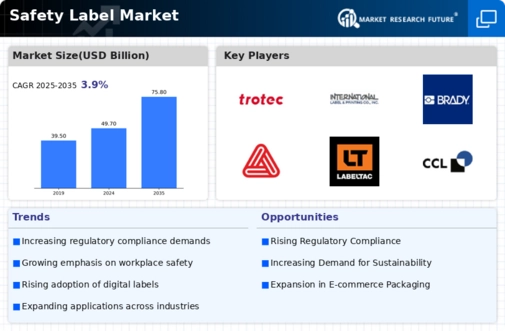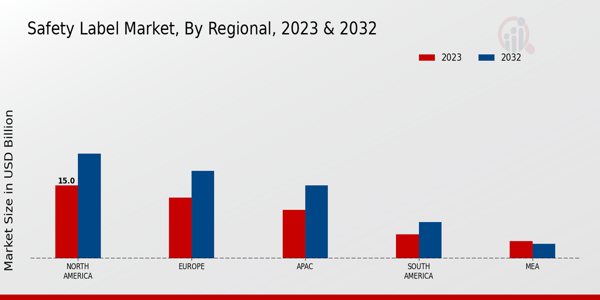Regulatory Compliance
The Global Safety Label Market Industry is significantly driven by stringent regulatory requirements across various sectors. Governments worldwide enforce regulations that mandate the use of safety labels to ensure consumer protection and workplace safety. For instance, the Occupational Safety and Health Administration (OSHA) in the United States requires specific labeling for hazardous materials. This regulatory landscape not only compels manufacturers to adopt safety labels but also fosters a culture of safety within organizations. As a result, the market is projected to reach 49.7 USD Billion in 2024, reflecting the increasing emphasis on compliance and safety standards.
Market Growth Projections
The Global Safety Label Market Industry is projected to experience substantial growth in the coming years. The market is anticipated to reach 49.7 USD Billion in 2024, with a steady increase expected to 75.8 USD Billion by 2035. This growth trajectory reflects a compound annual growth rate (CAGR) of 3.91% from 2025 to 2035. The increasing demand for safety labels across various sectors, driven by regulatory compliance, technological advancements, and growing awareness of safety standards, is likely to propel this market forward. The projections indicate a robust market landscape, characterized by evolving consumer needs and industry dynamics.
Technological Advancements
Technological innovations play a pivotal role in shaping the Global Safety Label Market Industry. The integration of advanced printing technologies and materials enhances the durability and visibility of safety labels. For example, the adoption of digital printing allows for high-quality, customizable labels that can withstand harsh environments. Additionally, the development of smart labels equipped with QR codes or NFC technology enables real-time information access regarding safety protocols. Such advancements not only improve label effectiveness but also cater to the evolving needs of industries. Consequently, the market is expected to grow at a CAGR of 3.91% from 2025 to 2035, indicating a robust trajectory driven by technological progress.
Expansion of End-User Industries
The expansion of end-user industries significantly influences the Global Safety Label Market Industry. Sectors such as food and beverage, chemicals, and pharmaceuticals are experiencing rapid growth, leading to an increased need for safety labeling solutions. For instance, the food industry mandates clear labeling to inform consumers about allergens and nutritional information. As these industries expand globally, the demand for safety labels that comply with local regulations intensifies. This trend is expected to contribute to the market's growth, as businesses seek to enhance product safety and transparency. The overall market dynamics reflect a robust demand driven by the expansion of these critical sectors.
Growing Awareness of Safety Standards
Increasing awareness regarding safety standards among consumers and businesses is a crucial driver for the Global Safety Label Market Industry. As organizations prioritize safety and risk management, the demand for effective labeling solutions rises. Educational campaigns and training programs emphasize the importance of safety labels in preventing accidents and ensuring compliance with safety regulations. This heightened awareness is particularly evident in sectors such as manufacturing, construction, and healthcare. The market's growth is further supported by the projected increase in safety label adoption, with estimates suggesting it could reach 75.8 USD Billion by 2035, underscoring the collective commitment to enhancing safety practices.
Environmental Sustainability Initiatives
Environmental sustainability initiatives are increasingly shaping the Global Safety Label Market Industry. As organizations strive to reduce their environmental footprint, there is a growing demand for eco-friendly labeling solutions. This includes the use of recyclable materials and sustainable printing processes. Regulatory bodies are also promoting sustainable practices, encouraging businesses to adopt labels that align with environmental standards. For example, the European Union's Green Deal emphasizes sustainability in product labeling. This shift towards sustainability not only meets consumer expectations but also enhances brand reputation. Consequently, the market is poised for growth as businesses align their labeling strategies with environmental sustainability goals.











